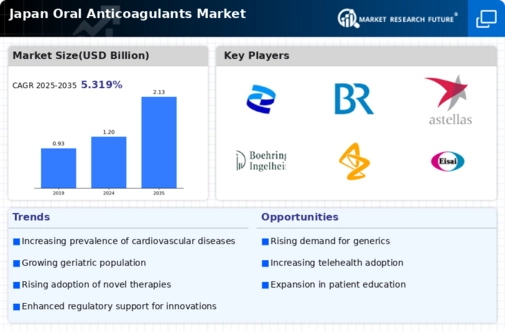Rising Awareness and Education on Thrombosis
Increased awareness and education regarding thrombosis and its associated risks are influencing the oral anticoagulants market in Japan. Public health campaigns and healthcare provider initiatives are effectively disseminating information about the importance of anticoagulation therapy in preventing strokes and other thromboembolic events. This heightened awareness is likely to lead to more patients seeking treatment options, thereby expanding the market. The oral anticoagulants market is benefiting from this trend, as healthcare professionals are more frequently recommending anticoagulants to at-risk populations. It is estimated that this awareness could contribute to a market growth of around 8% in the coming years, as more individuals are diagnosed and treated.
Regulatory Support and Reimbursement Policies
Regulatory support and favorable reimbursement policies are crucial drivers for the oral anticoagulants market in Japan. The Japanese government has been actively promoting the use of anticoagulants through various healthcare policies, which facilitate access to these medications. Additionally, the inclusion of newer anticoagulants in the national health insurance system has made them more accessible to patients. This supportive regulatory environment encourages healthcare providers to prescribe oral anticoagulants more liberally, thus driving market growth. The oral anticoagulants market is likely to see a positive impact from these policies, with projections indicating a potential increase in market size by 12% over the next few years as more patients gain access to effective treatments.
Advancements in Drug Development and Innovation
Innovations in drug development are propelling the oral anticoagulants market forward in Japan. The introduction of novel anticoagulants, which offer improved safety profiles and convenience, is reshaping treatment paradigms. For instance, the development of direct oral anticoagulants (DOACs) has provided alternatives to traditional vitamin K antagonists, which require regular monitoring. The oral anticoagulants market is witnessing a surge in research and development investments, with pharmaceutical companies focusing on creating more effective and patient-friendly options. This trend is expected to enhance patient adherence to treatment regimens, thereby increasing the overall market size. Analysts project that the market could grow by approximately 15% over the next five years, driven by these advancements.
Growing Prevalence of Lifestyle-Related Diseases
The rising prevalence of lifestyle-related diseases in Japan is significantly impacting the oral anticoagulants market. Conditions such as obesity, diabetes, and hypertension are becoming increasingly common, leading to a higher incidence of thromboembolic disorders. As these lifestyle-related diseases continue to rise, the demand for effective anticoagulation therapies is expected to grow correspondingly. The oral anticoagulants market is thus positioned to expand as healthcare providers seek to manage these conditions more effectively. Market analysts suggest that the growth rate could reach approximately 9% annually, driven by the need for anticoagulants in managing complications arising from these diseases.
Aging Population and Increased Incidence of Atrial Fibrillation
The aging population in Japan is a critical driver for the oral anticoagulants market. As individuals age, the risk of developing atrial fibrillation (AF) increases significantly. Reports indicate that approximately 1.5 million people in Japan are affected by AF, leading to a heightened demand for anticoagulant therapies. This demographic shift suggests that healthcare providers are likely to prescribe oral anticoagulants more frequently to manage this condition. Furthermore, the prevalence of other cardiovascular diseases among the elderly population further contributes to the growth of the market. The oral anticoagulants market is thus poised to expand as healthcare systems adapt to the needs of an aging society, potentially increasing market revenues by an estimated 10% annually over the next few years.

















Leave a Comment